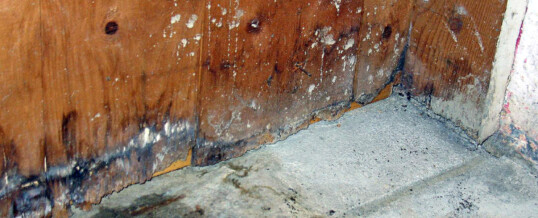
To new homeowners, a flooded basement is their worst nightmare. However, nearly 98% of basements experience water damage at some point.
Basement water damage can not only create problems with the structural integrity of a home, but it can also create a health hazard for homeowners if mold forms out of the collected moisture.
Basements can become more susceptible to water damage through many external factors. Determining where water damage is coming from is paramount in fixing the problem right the first time.
Even though waterproofing a basement seems like a scary, daunting task (especially to the new homeowner), you can break down the process into four steps: recognizing signs of water damage, considering the methods of waterproofing, and seeking out a trained professional to assist you.
Signs of Water Damage
There are several ways to know if water is seeping into your home and wreaking havoc in your basement. If caught early, you can prevent more serious property damage in the future.
Moisture in the basement creates a perfect breeding ground for mold to grow. If you find mold in your home, it is a sign you should start looking for a place water could be getting in. Often, the presence of mold will result in a musky odor that comes from wherever the mold is.
If you think your home has mold, you need to acquire professional help in seeking it out and ridding your home of it. Mold can be damaging to the health of yourself and your family.
Discolored paint is another sign of water getting into your basement. This discoloring will appear like a stain on your wall.
Once you find evidence of water damage, you can trace where the water might be getting into your home and set to work on fixing it! The sooner you fix the problem, the more money you will save on repairs.
1. Interior Drainage
If you find that your house experiences water damage, there are several methods you can use to waterproof from the inside.
The most effective way to prevent water damage from the interior is to install french drains below the floor of your basement. The way these drains work is similar to an exterior drain and is ideally installed during the construction of the home. Like an exterior drain, french drains collect water from the outside and pump it to the surface before it can cause structural damage.
The con of this kind of drainage is that it only will prevent water damage from the ground. You will still have to seal cracks in the wall. However, interior drainage can be a cost-effective way to avoid water damage.
2. Interior Basement Waterproofing
First, you have to consider the landscape around the basement. If there is a slope in the ground that directs water runoff toward your basement, you’ll need to redirect that flow in a less harmful direction.
If you find that water is getting into your basement through gaps in the walls, you can use hydraulic cement to seal the cracks. This kind of cement sealant is specially made to adhere to cement and penetrate deep into cracks and gaps that have formed. This will help prevent moisture and humidity from getting into the basement.
3. Exterior Waterproofing
To waterproof from the outside of a basement is to dig up the dirt around the basement foundation and install a drain tile. To do this, install a drain pit. Then install a sump pit to collect water from the drain. The sump pit will pump gathered water from the pit to the surface.
This process is done by a professional during the initial construction of the basement.
Also, you can seal all cracks and seams on the outside of the basement wall with masonry level sealant. You will most likely do this during the construction of the home, but you can easily complete it later if needed.
You can avoid future water damage by maintaining gutters and sealing any cracks in the exterior walls. However, if water does get in, you can suppliment exterior waterproofing with interior methods just as well.
This method does not protect from hydrostatic pressure.
Waterproofing is Worth the Investment
Determining what method of waterproofing is best for your home is going to depend on your specific circumstances. What works for one person’s home might not be the solution for you. Because of the varied circumstances that go along with water damage, it’s a wise decision to invest in professional help.
It’ll be worth the investment because you’ll have the peace of mind that comes along with knowing your home won’t flood. Filling the seals and gaps in your basement walls will make your A/C work more efficiently, and you’ll save money on energy bills.
Not to mention, by investing in professional basement waterproofing, you are preventing damage to the foundation of your home and adding to the overall value of the house.
Where to Find Professional Help
If you’ve found water damage in your basement, hiring a professional to address the problem is your safest bet. Professionals have experience dealing with basements leaks, and they will be able to track down the source fast and efficiently. Many times, you will need a permit to work on your home’s basement. A professional will be able to acquire that permit much faster than you would be able to on your own.
Because repairing a basement is very labor-intensive, there are risks involved. Thankfully, an experienced professional is trained in how to safely repair and waterproof your basement.
If you’re experiencing water damage in your basement, feel free the call us. We have the knowledge to answer all your questions about basement waterproofing. Contact us today to schedule your free inspection!
ShareDEC
